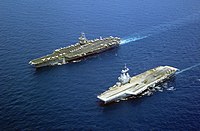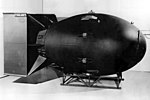ആണവായുധവിദ്യ സ്വായത്തമാക്കിയ രാജ്യങ്ങൾ
ഇത് ആണവായുധം സ്വായത്തമാക്കിയ രാജ്യങ്ങളുടെ പട്ടിക ആണ്; ഈ പട്ടിക പലപ്പോഴും "ന്യൂക്ലിയാർ ക്ലബ്" എന്നറിയപ്പെടുന്നു. നിലവിൽ എട്ടു രാജ്യങ്ങൾ വിജയകരമായി അണുവായുധങ്ങൾ പരീക്ഷിച്ചിട്ടുണ്ട്. ഇതിൽ അഞ്ചു രാജ്യങ്ങൾ അണുവായുധ രാഷ്ട്രങ്ങൾ എന്ന് അന്താരാഷ്ട്ര തലത്തിൽ അംഗീകരിക്കപ്പെട്ട അണുവായുധ നിർവ്യാപന കരാർ (Nuclear Non-Proliferation Treaty (NPT))വഴിയായി അറിയപ്പെടുന്നു. ഈ രാജ്യങ്ങൾ, അവ പ്രസ്തുത ശേഷി കൈവരിച്ച സമയക്രമത്തിൽ: അമേരിക്കൻ ഐക്യനാടുകൾ, റഷ്യ (സോവ്യറ്റ് യൂണിയന്റെ പിൻഗാമി), യുണൈറ്റഡ് കിംഗ്ഡം, ഫ്രാൻസ്, ചൈന എന്നിയവാണ്.
അണുവായുധ നിർവ്യാപന കരാർ രൂപപ്പെടുത്തിയ ശേഷം അതിൽ ഒപ്പുവയ്ക്കാത്ത മൂന്നു രാഷ്ട്രങ്ങൾ - ഇന്ത്യ, പാകിസ്താൻ, ഉത്തര കൊറിയ- അണുവായുധ പരീക്ഷണങ്ങൾ നടത്തി. ഇസ്രായേലിനും അണുവായുധങ്ങളുള്ളതായി വ്യാപകമായി വിശ്വസിച്ചു പോരുന്നു. എന്നാൽ ഇസ്രായേൽ പ്രസ്തുത ആരോപണത്തെ അംഗീകരിക്കുകയോ നിരാകരിക്കുകയോ ചെയ്തിട്ടില്ല.[1] ഈ രാജ്യങ്ങൾ അണുവായുധ നിർവ്യാപന കരാറിൽ ഒപ്പുവയ്ക്കാത്തതിനാൽ ഇവയുടെ അണുവായുധ ശേഷി ഔദ്യോഗികമായി അംഗീകരിക്കപ്പെട്ടിട്ടില്ല.
ഇറാന് അണുവായുധ വികസന പദ്ധതി ഉള്ളതായി അമേരിക്ക ആരോപിക്കുന്നു. എന്നാൽ ഇറാൻ പ്രസ്തുത ആരോപണം നിരാകരിക്കുന്നു.
ലോകത്താകമാനമുള്ള അണുവായുധശേഖരത്തിന്റെ ഏകദേശ കണക്ക്[തിരുത്തുക]
| രാജ്യം | അണുവായുധ പോർമുനകൾ സജ്ജം/മൊത്തം* | ആദ്യം പരീക്ഷണം നടത്തിയ വർഷം |
|---|---|---|
| ആണവായുധം സ്വായത്തമാക്കിയ അഞ്ചു രാഷ്ട്രങ്ങൾ - അണുവായുധ നിർവ്യാപന കരാർ പ്രകാരം | ||
| 5,735/9,960[2] | 1945 ("Trinity") | |
| 5,830/16,000[3] | 1949 ("RDS-1") | |
| 200[4] | 1952 ("Hurricane") | |
| 350[5] | 1960 ("Gerboise Bleue") | |
| 130[6] | 1964 ("596") | |
| അണുവായുധ ശേഷിയുള്ള മറ്റു രാഷ്ട്രങ്ങൾ | ||
| 70-120[7] | 1974 ("Smiling Buddha") | |
| 30-52[8] | 1998 ("Chagai-I") | |
| 1-10[9] | 2006 (The Beginning)[10] | |
| അണുവായുധ ശേഷി പ്രസിദ്ധപ്പെടുത്താത്ത രാഷ്ട്രങ്ങൾ | ||
| 75-200[11] | ഇല്ല അല്ലെങ്കിൽ വ്യക്തമല്ല അല്ലെങ്കിൽ 1979 (വെല സംഭവം കാണുക) | |
*All numbers are estimates from the Natural Resources Defense Council, published in the Bulletin of the Atomic Scientists, unless other references are given. If differences between active and total stockpile are known, they are given as two figures separated by a forward slash. If no specifics are known, only one figure is given. Stockpile number may not contain all intact warheads if a substantial amount of warheads are scheduled for but have not yet gone through dismantlement; not all "active" warheads are deployed at any given time. When a range of weapons is given (e.g., 0–10), it generally indicates that the estimate is being made on the amount of fissile material that has likely been produced, and the amount of fissile material needed per warhead depends on estimates of a country's proficiency at nuclear weapon design.
അണുവായുധ നിർവ്യാപന കരാർ പ്രകാരം ആണവായുധം സ്വായത്തമാക്കിയ അഞ്ചു രാഷ്ട്രങ്ങൾ[തിരുത്തുക]



അണുവായുധ ശേഷിയുള്ള മറ്റു രാഷ്ട്രങ്ങൾ[തിരുത്തുക]
അണുവായുധ ശേഷി പ്രസിദ്ധപ്പെടുത്താത്ത രാഷ്ട്രങ്ങൾ[തിരുത്തുക]
അണുവായുധ വികസന പദ്ധതികൾ ഉണ്ടെന്ന് ആരോപിക്കപ്പെടുന്ന രാഷ്ട്രങ്ങൾ[തിരുത്തുക]
മുൻ സോവിയറ്റ് രാഷ്ട്രങ്ങൾ[തിരുത്തുക]
അവലംബം[തിരുത്തുക]
- ↑ http://www.guardian.co.uk/israel/Story/0,,1970616,00.html
- ↑ Norris, Robert S. and Hans M. Kristensen. "U.S. nuclear forces, 2006," Bulletin of the Atomic Scientists 61:1 (January/February 2005): 68-71, [1] Archived 2006-09-28 at the Wayback Machine.
- ↑ Norris, Robert S. and Hans M. Kristensen. "Russian nuclear forces, 2006," Bulletin of the Atomic Scientists 62:2 (March/April 2006): 64-67, [2] Archived 2006-09-28 at the Wayback Machine.
- ↑ Norris, Robert S. and Hans M. Kristensen. "British nuclear forces, 2005," Bulletin of the Atomic Scientists 61:6 (November/December 2005): 77-79, [3] Archived 2006-09-28 at the Wayback Machine.
- ↑ Norris, Robert S. and Hans M. Kristensen. "French nuclear forces, 2005," Bulletin of the Atomic Scientists 61:4 (July/August 2005): 73-75,[4] Archived 2006-09-28 at the Wayback Machine.
- ↑ Norris, Robert S. and Hans M. Kristensen. "Chinese nuclear forces, 2006," Bulletin of the Atomic Scientists 62:3 (May/June 2006): 60-63, [5] Archived 2006-09-28 at the Wayback Machine.; Lewis, Jeffery. "The ambiguous arsenal," Bulletin of the Atomic Scientists 61:3 (May/June 2005): 52-59. [6] Archived 2006-09-28 at the Wayback Machine..
- ↑ Norris, Robert S. and Hans M. Kristensen. "India's nuclear forces, 2005," Bulletin of the Atomic Scientists 61:5 (September/October 2005): 73-75,[7]
- ↑ Norris, Robert S. and Hans M. Kristensen. "Pakistan's nuclear forces, 2001," Bulletin of the Atomic Scientists 58:1 (January/February 2002): 70-71,[8] Archived 2006-12-17 at the Wayback Machine.
- ↑ Norris, Robert S. and Hans M. Kristensen. "North Korea's nuclear program, 2005," Bulletin of the Atomic Scientists 61:3 (May/June 2005): 64-67,[9] Archived 2006-09-28 at the Wayback Machine.
- ↑ globalsecurity.org. Nuclear Weapons Testing - North Korean Statements
- ↑ Norris, Robert S., William Arkin, Hans M. Kristensen, and Joshua Handler. "Israeli nuclear forces, 2002," Bulletin of the Atomic Scientists 58:5 (September/October 2002): 73-75, [10] Archived 2006-09-28 at the Wayback Machine.
- ↑ Hansen, Chuck (1988). U.S. nuclear weapons: The secret history. Arlington, TX: Aerofax. ISBN 0-517-56740-7.
- ↑ Hansen, Chuck (1995). The Swords of Armageddon: U.S. nuclear weapons development since 1945. Sunnyvale, CA: Chukelea Publications.
പുറത്തേക്കുള്ള കണ്ണികൾ[തിരുത്തുക]
- "Global Nuclear Stockpiles, 1945–2006" from Bulletin of the Atomic Scientists
- Nuclear Threat Initiative
- Globalsecurity.org — World Special Weapons Guide
- The Nuclear Weapon Archive
- U.S. Nuclear Weapons in Europe: A review of post-Cold War policy, force levels, and war planning NRDC, February 2005
- Pakistani Nuclear Development[പ്രവർത്തിക്കാത്ത കണ്ണി]
- Online NewsHour with Jim Lehrer:Tracking Nuclear Proliferation Archived 2007-12-08 at the Wayback Machine.


